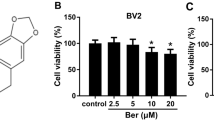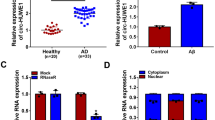Abstract
Accumulating articles reported that berberine (Ber) played a neuroprotective role in Alzheimer’s disease (AD). Long noncoding RNAs (lncRNAs) have been identified as biomarkers and therapeutic targets of AD. However, the precise mechanism by which lncRNA β-amyloid cleaving enzyme 1 antisense RNA (BACE1-AS)regulates the progression of AD remains largely unknown. HPN and SK-N-SH cells treated with amyloid β 25–35 (Aβ25–35) were regarded as AD model in vitro. Cell survival rate was measured by 3-(4,5-dimethylthiazol-2-yl)-2,5-diphenyltetrazolium bromide (MTT) assay. Lactate dehydrogenase (LDH) cytotoxicity assay was conducted to detect the cytotoxicity of neuronal cells. Flow cytometry was performed to determine the intracellular concentration of Ca2+, reactive oxygen species (ROS) and apoptosis of neuronal cells. Western blot assay was carried out to detect the apoptosis-related proteins of neuronal cells. The abundance of lncRNA BACE1-AS and miR-132-3p was measured by quantitative real time polymerase chain reaction (qRT-PCR). The binding sites between miR-132-3p and BACE1-AS were predicted by Starbase, and the combination was confirmed by dual-luciferase reporter assay. We found that Ber alleviated Aβ25–35 induced neuronal injury in AD model, especially in high concentration Ber group. The enrichment of BACE1-AS was positively regulated by Aβ25–35 and was inversely modulated by Ber in neuronal cells. The interference of BACE1-AS alleviated the neuronal damage of AD model. miR-132-3p was a direct target of lncRNA BACE1-AS in HEK293T cells, and it was negatively regulated by BACE1-AS in neuronal cells. BACE1-AS accumulation reversed the protective effect of miR-132-3p overexpression on AD model. Ber treatment and BACE1-AS intervention recovered the viability of AD model. Ber up-regulated the level of miR-132-3p via BACE1-AS in SK-N-SH and HPN neuronal cells. in conclucsion, Ber protected neuronal cells against Aβ25–35 at least partly through BACE1-AS/miR-132-3p axis. The combined therapy of Ber treatment with BACE1-AS depletion might provide new insight into AD treatment.







Similar content being viewed by others
References
Scheltens P, Blennow K, Breteler MM, de Strooper B, Frisoni GB, Salloway S et al (2016) Alzheimer's disease. Lancet 388:505–517
Tang J, Feng Y, Tsao S, Wang N, Curtain R, Wang Y (2009) Berberine and Coptidis rhizoma as novel antineoplastic agents: a review of traditional use and biomedical investigations. J Ethnopharmacol 126:5–17
Yuan NN, Cai CZ, Wu MY, Su HX, Li M, Lu JH (2019) Neuroprotective effects of berberine in animal models of Alzheimer's disease: a systematic review of pre-clinical studies. BMC Complement Altern Med 19:109
Yang J, Lin J, Liu T, Chen T, Pan S, Huang W et al (2014) Analysis of lncRNA expression profiles in non-small cell lung cancers (NSCLC) and their clinical subtypes. Lung Cancer 85:110–115
Guenzl PM, Barlow DP (2012) Macro lncRNAs: a new layer of cis-regulatory information in the mammalian genome. RNA Biol 9:731–741
Li CH, Chen Y (2013) Targeting long non-coding RNAs in cancers: progress and prospects. Int J Biochem Cell Biol 45:1895–1910
Qi P, Du X (2013) The long non-coding RNAs, a new cancer diagnostic and therapeutic gold mine. Mod Pathol 26:155–165
Xu MD, Qi P, Du X (2014) Long non-coding RNAs in colorectal cancer: implications for pathogenesis and clinical application. Mod Pathol 27:1310–1320
Dykes IM, Emanueli C (2017) Transcriptional and post-transcriptional gene regulation by long non-coding RNA. Genom Proteom Bioinform 15:177–186
Cesana M, Cacchiarelli D, Legnini I, Santini T, Sthandier O, Chinappi M et al (2011) A long noncoding RNA controls muscle differentiation by functioning as a competing endogenous RNA. Cell 147:358–369
Kallen AN, Zhou XB, Xu J, Qiao C, Ma J, Yan L et al (2013) The imprinted H19 lncRNA antagonizes let-7 microRNAs. Mol Cell 52:101–112
Wang K, Long B, Zhou LY, Liu F, Zhou QY, Liu CY et al (2014) CARL lncRNA inhibits anoxia-induced mitochondrial fission and apoptosis in cardiomyocytes by impairing miR-539-dependent PHB2 downregulation. Nat Commun 5:3596
Vassar R, Bennett BD, Babu-Khan S, Kahn S, Mendiaz EA, Denis P et al (1999) Beta-secretase cleavage of Alzheimer's amyloid precursor protein by the transmembrane aspartic protease BACE. Science 286:735–741
Faghihi MA, Modarresi F, Khalil AM, Wood DE, Sahagan BG, Morgan TE et al (2008) Expression of a noncoding RNA is elevated in Alzheimer's disease and drives rapid feed-forward regulation of beta-secretase. Nat Med 14:723–730
Ambros V (2004) The functions of animal microRNAs. Nature 431:350–355
Calin GA, Croce CM (2006) MicroRNA signatures in human cancers. Nat Rev Cancer 6:857–866
Lagos-Quintana M, Rauhut R, Lendeckel W, Tuschl T (2001) Identification of novel genes coding for small expressed RNAs. Science 294:853–858
Cogswell JP, Ward J, Taylor IA, Waters M, Shi Y, Cannon B et al (2008) Identification of miRNA changes in Alzheimer's disease brain and CSF yields putative biomarkers and insights into disease pathways. J Alzheimers Dis 14:27–41
Lau P, Bossers K, Janky R, Salta E, Frigerio CS, Barbash S et al (2013) Alteration of the microRNA network during the progression of Alzheimer's disease. EMBO Mol Med 5:1613–1634
Hebert SS, Wang WX, Zhu Q, Nelson PT (2013) A study of small RNAs from cerebral neocortex of pathology-verified Alzheimer's disease, dementia with lewy bodies, hippocampal sclerosis, frontotemporal lobar dementia, and non-demented human controls. J Alzheimers Dis 35:335–348
Wong HK, Veremeyko T, Patel N, Lemere CA, Walsh DM, Esau C et al (2013) De-repression of FOXO3a death axis by microRNA-132 and -212 causes neuronal apoptosis in Alzheimer's disease. Hum Mol Genet 22:3077–3092
Smith PY, Hernandez-Rapp J, Jolivette F, Lecours C, Bisht K, Goupil C et al (2015) miR-132/212 deficiency impairs tau metabolism and promotes pathological aggregation in vivo. Hum Mol Genet 24:6721–6735
Livak KJ, Schmittgen TD (2001) Analysis of relative gene expression data using real-time quantitative PCR and the 2(-Delta Delta C(T)) Method. Methods 25:402–408
Xu J, Wu W, Zhang H, Yang L (2018) Berberine alleviates amyloid beta25-35-induced inflammatory response in human neuroblastoma cells by inhibiting proinflammatory factors. Exp Ther Med 16:4865–4872
Ke S, Yang Z, Yang F, Wang X, Tan J, Liao B (2019) Long noncoding RNA NEAT1 aggravates abeta-induced neuronal damage by targeting miR-107 in Alzheimer's disease. Yonsei Med J 60:640–650
Wang H, Lu B, Chen J (2019) Knockdown of lncRNA SNHG1 attenuated Abeta25-35-inudced neuronal injury via regulating KREMEN1 by acting as a ceRNA of miR-137 in neuronal cells. Biochem Biophys Res Commun 518:438–444
Fotuhi SN, Khalaj-Kondori M, Hoseinpour Feizi MA, Talebi M (2019) Long non-coding RNA BACE1-AS may serve as an alzheimer's disease blood-based biomarker. J Mol Neurosci. 69:351–359
Li F, Wang Y, Yang H, Xu Y, Zhou X, Zhang X, Xie Z, Bi J (2019) The effect of BACE1-AS on beta-amyloid generation by regulating BACE1 mRNA expression. BMC Mol Biol 20:23
Zhang W, Zhao H, Wu Q, Xu W, Xia M (2018) Knockdown of BACE1-AS by siRNA improves memory and learning behaviors in Alzheimer's disease animal model. Exp Ther Med 16:2080–2086
Pichler S, Gu W, Hartl D, Gasparoni G, Leidinger P, Keller A et al (2017) The miRNome of Alzheimer's disease: consistent downregulation of the miR-132/212 cluster. Neurobiol Aging 50:167.e1–e10
Satoh J (2010) MicroRNAs and their therapeutic potential for human diseases: aberrant microRNA expression in Alzheimer's disease brains. J Pharmacol Sci 114:269–275
Salta E, De Strooper B (2017) microRNA-132: a key noncoding RNA operating in the cellular phase of Alzheimer's disease. Faseb J 31:424–433
Funding
This work was supported by the Science and Technology Office of Henan Province (scientific and technological project) (Grant Number: 162102310289) and Science and Technology Office of Henan Province (international program) (Grant Number: 124300510017).
Author information
Authors and Affiliations
Corresponding authors
Ethics declarations
Conflict of interest
The authors declare that they have no financial conflicts of interest.
Additional information
Publisher's Note
Springer Nature remains neutral with regard to jurisdictional claims in published maps and institutional affiliations.
Rights and permissions
About this article
Cite this article
Ge, Y., Song, X., Liu, J. et al. The Combined Therapy of Berberine Treatment with lncRNA BACE1-AS Depletion Attenuates Aβ25–35 Induced Neuronal Injury Through Regulating the Expression of miR-132-3p in Neuronal Cells. Neurochem Res 45, 741–751 (2020). https://doi.org/10.1007/s11064-019-02947-6
Received:
Revised:
Accepted:
Published:
Issue Date:
DOI: https://doi.org/10.1007/s11064-019-02947-6




